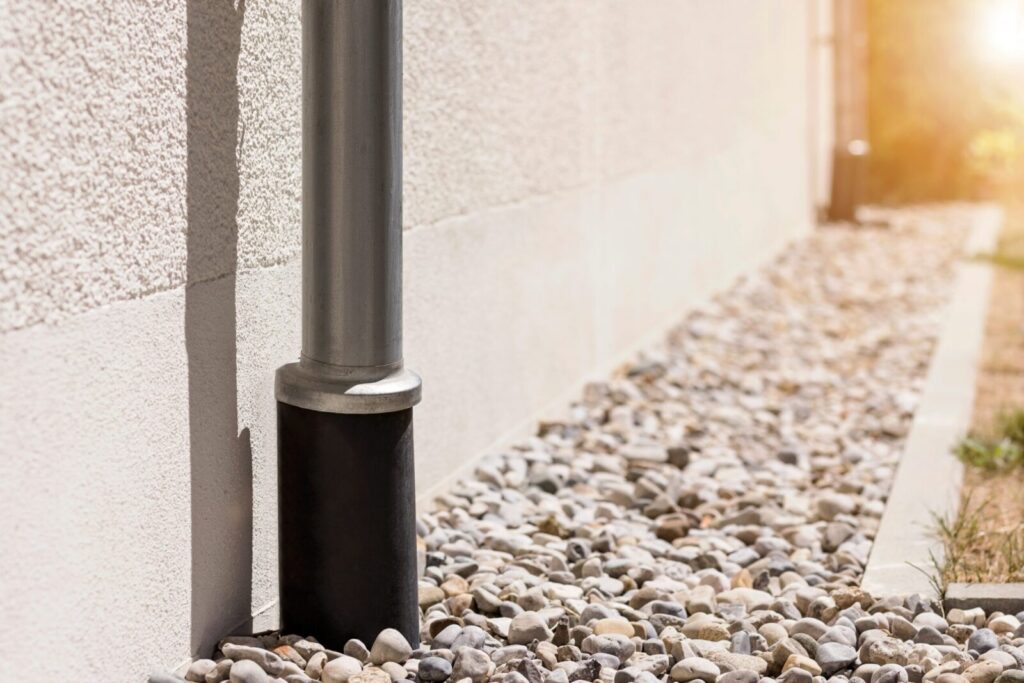Have you had enough of dealing with a wet basement every time it rains? A properly installed French drain will do amazing things for the damp conditions in your home.
French drains can be installed inside or outside, but both use plastic pipes with perforations on the bottom to waterproof your basement by collecting moisture and redirecting it away from your home’s foundation. Many basements also have a sump pump and French drain working in tandem to expel water into the nearest storm drain. Keep reading to learn more about French drains and how they can benefit your property.
What is a French Drain?
A French drain consists of a gravel or rock-filled trench and often includes a perforated pipe. The drain collects rainwater or surface water and redirects it away from a specific area, such as your basement floor.
Ensuring wet or moisture-prone areas have good drainage helps to safeguard your home’s foundation, but French drains are also great for gardens, driveways, or any other area susceptible to flooding or pooling moisture.
Why Do Basements Get Wet?
Basement flooding is an issue that many homeowners need to deal with before it develops into mold, mildew, and structural problems. Various factors can contribute to basement flooding, such as water flowing in from outside or moisture seeping up through the floor.
Water seepage can damage your foundation over time and may even contribute to poor air quality because of high humidity and mold spores. A wet basement can also decrease the value of your home, create electrical hazards, and attract pest infestation. Dealing with water seepage immediately is the best way to stop these conditions from escalating.
How Can a French Drain Help?
French drain systems are highly effective basement waterproofing solutions homeowners can rely on to solve moisture issues. Here are a few more on the benefits they can provide:
Divert Water: This is the primary purpose of a French drain, to divert excess moisture away from an area with drainage problems.
Stop Basement Flooding: A basement or crawl space can suffer from standing water and intrusion issues. A French drain installed around the perimeter of your home’s foundation will help maintain your property’s structural integrity. It intercepts groundwater before it reaches the basement and redirects it out of the property or into a sump pump basin.
Protect the Foundation: Diverting water away from the foundation to keep it dry will help maintain your home’s structural integrity. Excessive moisture in the basement puts excessive pressure on the floor and walls, eventually leading to cracks and other types of damage.
Stop Soil Erosion: Areas with poor drainage and water runoff cause soil erosion, potentially leading to landscape damage and structural issues. French drains control the water flow to prevent soil erosion and protect the integrity of your property.
Preventing Mold and Mildew: Water in your basement that is not dealt with will develop into mold and mildew problems. Mold releases spores, which can make their way into your home and cause health issues like allergies.
Maintain Property Value: A French drain will improve the value of your property as it is a home improvement that prevents water damage.
While French drains are one of the best solutions for controlling moisture around a property, it’s critical they are correctly installed to get the most benefit. If you don’t have experience with this type of construction project, a professional French drain installation service is highly recommended.
French Drain Maintenance
French drains can suffer from a few problems if not maintained adequately like any other type of drain. Keep your French drain working efficiently with the following tips:
Regular Testing
If you have your French drain installed by professionals, they will test it once the work is done. However, periodic testing will help you monitor how well your drain performs.
You can quickly test the drain by flooding it and checking how well the water flows. Locate the ground-level access point, which is usually a grate you can find above ground. Remove the cap and stick a hose into the pipe. A system that’s in good order should be able to handle the volume of water from a garden hose.
Another good tip to note when testing the drain is to ensure you are standing clear. If your French drain has any blockages, a sudden jet of water will hit the obstruction and splash back through the opening, likely covering you with unpleasant gunk in the process. It’s a good idea to wear safety glasses as well.
Deal with Clogs and Blockages
French drains can develop clogs and blockages somewhere in the pipe. Weep holes in the bottom of the pipe are made large to ensure optimum water flow. Unfortunately, the caveat is that they don’t filter out mud or silt.
Weeds and tree roots will also take advantage of weep holes, especially if there’s plenty of nutrient-rich sediment and mud. Check for and clean out these obstructions at least once or twice a year to avoid any nasty surprises during heavy rain.
You can do a lot with a garden hose, but sometimes a little more power is warranted. A heavy-duty drain snake will make short work of stubborn clogs. These devices have powerful motors that will churn through and break up solid lumps you can then clear out with the garden hose. A drain snake can be a dangerous tool in the wrong hands, so consider a service that specializes in French drain maintenance.
Check the Area Surrounding the French Drain
French drains can develop issues not directly related to clogs or blockages. For this reason, you should periodically check the surrounding area for any potential problems.
Tree roots growing underneath the drain can alter its pitch, impacting its ability to drain. A large enough tree root can even cause connections to separate. Check the area around your French drain for signs of swelling and upheaval and address them as needed.
Are You Ready to Solve Your Wet Basement Problems?
A French drainage system is a reliable solution to an age-old basement problem. Installing a French drain can solve your water seepage problems, drain water away, protect your home, and improve your quality of life.
Whether you need a French drain installation service or have noticed issues in your existing one, our team of professionals will ensure your basement stays dry, protecting your home’s foundation and enhancing its value. Contact us today to improve your quality of life and add value to your home with a French drainage system.

